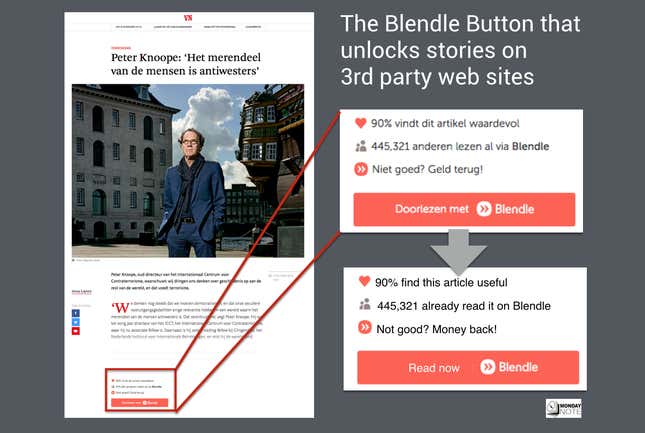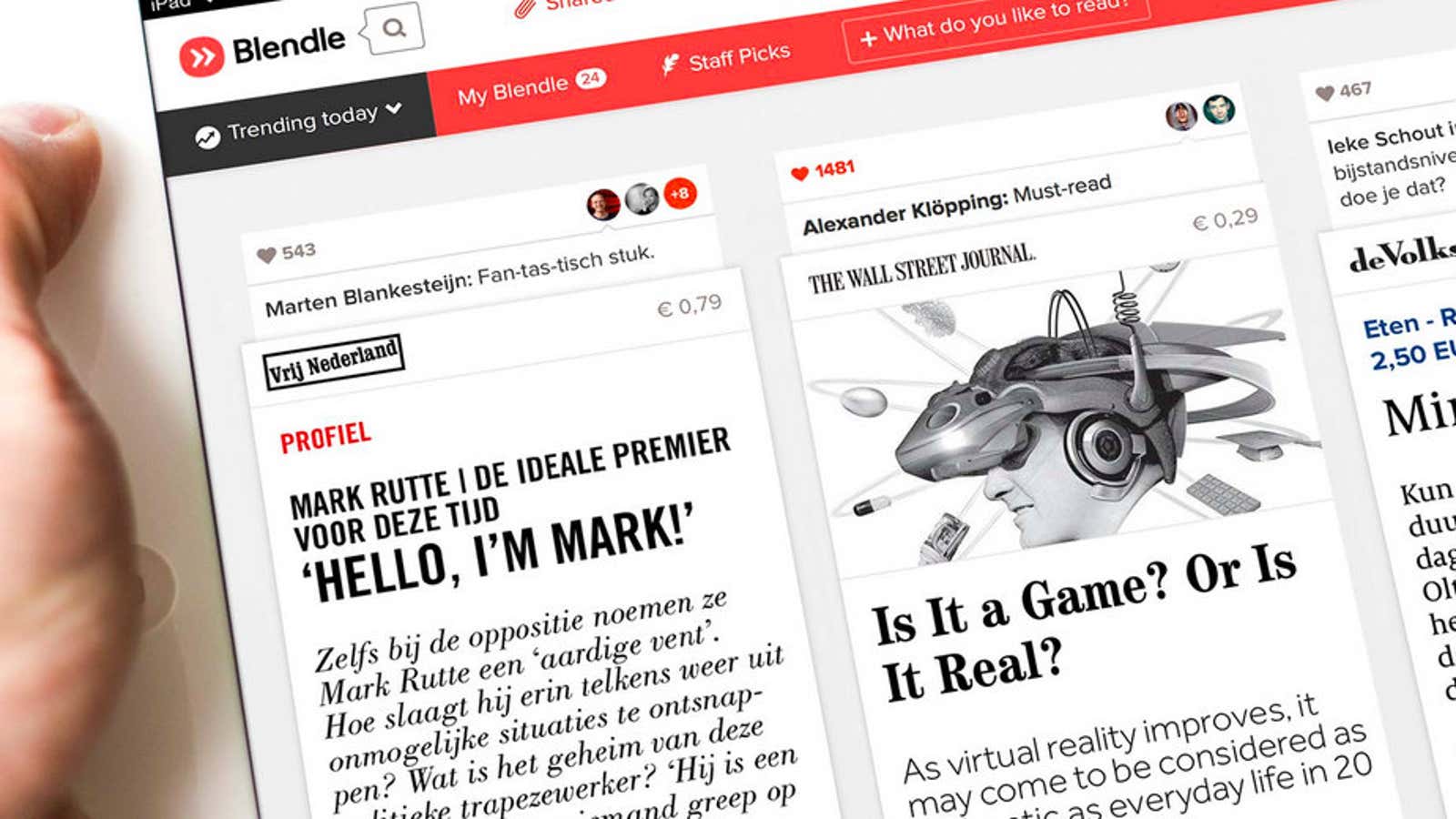Behind Blendle’s facade lies a complex set of tools aimed at expanding the reach of paid-for editorial: a recommendation engine; the possibility for publishers to use parts of Blendle’s back office for content optimization; a revisited transaction system, all of which could have serious impact on the news ecosystem. Here is a peek under Blendle’s hood. (This is the second part of a series. Part one is here.)
Blendle isn’t just about unbundling the traditional news package. The Dutch startup is quietly building a set of tools for the publishing industry that goes well beyond selling stories by the slice within a neatly designed interface—with all the controversial economics that go with such a business model.
In a recent conversation, company co-founder Alexander Klöpping related an anecdote that piqued my interest.
On Sept. 8 of this year, famous Dutch writer, poet, and essayist Joost Zwagerman took his own life in his Amsterdam house. Five days before, he gave a long interview to HP/De Tijd, a monthly magazine covering politics, culture, and science. In a moving exchange, Zwagerman revealed he suffered from an incurable disease. The story was to run in the magazine’s October issue due three weeks later. The publishers faced a dilemma. On the one hand, this was great journalistic material that shouldn’t be spoiled on HP/De Tijd free website, which serves mostly as a teaser for the print edition; on the other hand, waiting a month wasn’t a workable option. “The publisher called me to ask if Blendle could run the piece on a stand alone basis… We said yes, of course!” Once edited, the story was put on Blendle (use Google Translate) at a price of €1 ($1.30). As expected, it sold very well (Klöpping declined to give specifics). But more than that, weeks later, the move acted as a boost for the sale of magazine copies that featured the Zwagerman interview on twelve pages.
To Alexander Klöpping, the De Tijd tactic is the perfect illustration of an upcoming trend in which publications could use Blendle as a promotional vehicle for their content without giving away the value, the uniqueness conveyed to readers—a great story could go on Blendle as a prelude to more coverage in the full edition still in the making. “Our interests are aligned, says Klöpping. Many magazines could follow the same path. As an example, consider Vanity Fair’s high profile pieces such as Caitlyn Jenner’s. This completely changes the dynamic for important stories…” (No doubt that Klöpping pitched the idea to Condé Nast, to be part of Blendle’s next year push on the US market.)
Allowing publishers to build on Blendle’s features in order to serve their promotion needs is now part of the platform strategy. Blendle is working on an interface that will let publishers edit copy and layout, as well as performing A/B testing on their production.
Before that, the core of Blendle’s platform lies in a recommendation engine that goes through endless refinements. “We went through three phases,” explains Klöpping. Initially Blendle started with the usual social recommendations en vogue at the time. That didn’t work well. “Then, we picked up journalism students that came up at 3 o’clock in the morning, read everything they could; but they ended up selecting only very dry, long-form stories, which wasn’t what we wanted either. (It seems that whether in Amsterdam or Paris, journalism students, when left alone, end picking the most depressing and dullest topics they can think of…)
After a few tries, Blendle’s editorial team settled for a balanced approach with a mixture of human curation backed by strong analytics and algorithms. First, picky editors select no more than eight to 10 stories per newsletter. Then, they look at scores of behavioral data: preferred genres, topics, or length (actually Blendle readers favor long, analytic pieces as opposed to news wraps they can find elsewhere for free).
As experienced by the Wall Street Journal, one of the few English speaking publications currently available on Blendle, reader choices yield surprising results. “The stories they pick on Blendle are different from what gets funneled into our Journal subscription,” says Katie Vanneck-Smith, chief customer officer and global managing director at Dow Jones. WSJ stories appearing on Blendle are priced between €0.50 and €0.90. “Stories [read on Blendle] are mostly tech-oriented; people select pieces on US technologies companies, new devices, etc. This is good for us since we invested a lot in our technology coverage—which represents an effort comparable to maintaining our foreign news bureaus… One of the interesting things is these readers are the ones that you won’t expect to pay for content. Still, they reward the depth and the uniqueness of our coverage, even though there is a profusion of free content available everywhere on technology…”
At this time, she says, for the Wall Street Journal, this is mostly an experiment in which audience behavioral analysis is more important that actual sales figures. Katie Vanneck-Smith’s team also looks at how Blendle could actually funnel more subscriptions to the Journal: it currently has currently 750,000 digital subscribers paying $28.99 a month; that’s a theoretical revenue of $260 million per year before taking promotional discounts into account. In dealing with Blendle, the Wall Street Journal is considering the full extent of features available on the platform, including the “Blendle Button” introduced in the Netherlands. Paywalls structured like the WSJ’s lock most stories inside—as opposed to the metered system used by the New York Times. Blendle will propose a simple button such as this one, implemented on the Dutch publication VN.nl:

I tested it and it works seamlessly: When I go to the VN site, the Blendle cookie in my browser verifies that I have an active account and proposes to unlock the story with a single click, while debiting my account. Wherever the Blendle button is implemented, the reader will enjoy a friction-free experience. That’s a huge step forward. No wonder the Wall Street Journal is considering it.
The button is a critical part of Blendle’s strategy. “No one has cracked the paywall code yet,” says Klöpping. “We can become the global paywall infrastructure for quality media.” There still is a long way to go but Blendle is thorough, agile, and supremely confident.
This post originally appeared at Monday Note.




